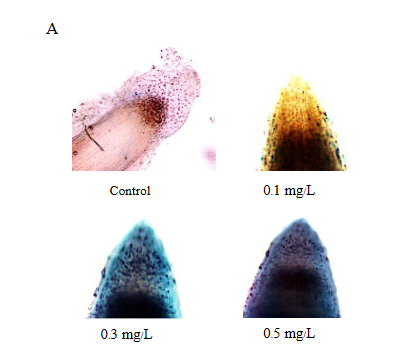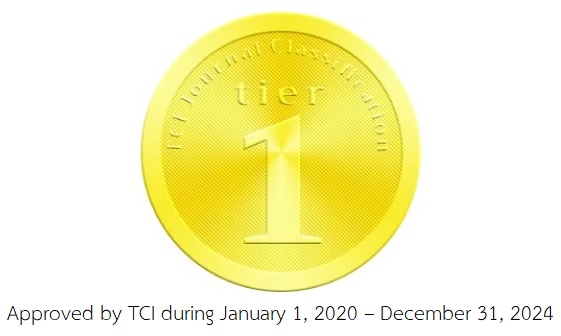Inhibitory Effect of Cadmium on the Growth of Mung Bean (Vigna radiata (L.) R. Wilczek) and the Removal by Chelating Agent
DOI:
https://doi.org/10.53848/ssstj.v10i1.410Keywords:
Cadmium toxicity, Mung bean, Evan’s blue, Chelating agentAbstract
This research studied the effect of cadmium (Cd) on the growth of mung bean (Vigna radiata (L.) R. Wilczek). The mung bean was cultured in a Hoagland solution containing different concentrations of Cd (0, 0.1, 0.3 and 0.5 mg/L) for 5 days. The result showed a significant decrease in the lengths of the roots and shoots of mung bean that was grown in cadmium solution. This effect was proportional to the concentrations of Cd. To assess cell death in the root of mung bean, Evan’ s blue staining technique was used in this study. The results showed that the concentrations of Evan's blue dye taken up by Cd-exposed mung beans at 0.1, 0.3, and 0.5 mg/L were 1.5612 ± 0.5417, 6.8641 ± 1.7447, and 8.0850 ± 2.6336 mg/L, respectively. A concentration-dependent increase of dead cells
was found in the Cd-treated group, mostly at the root cap zone. With respect to this result, the level of dead cells that was stained with Evan’s blue dye could be used as a biomarker to indicate cadmium contamination in water. Furthermore, the effects of chelating agents (EDTA) on cadmium removal were also studied. The results showed the possibility of using EDTA as a cadmium treatment agent and promoted plant growth in cadmium contamination areas.
References
Aqeel, M. , Khalid, N. , Tufail, A. , Ahmad, R. Z. , Akhter, M. S., Luqman, M., ... Noman, A. (2021).Elucidating the distinct interactive impact of
cadmium and nickel on growth,photosynthesis, metal- homeostasis, and yield responses of mung bean ( Vigna radiata L. )
varieties. Environmental Science and Pollution Research, 28(21), 27376-27390.doi:0.1007/s11356-021-12579-5
Asim, M., Aslam, M., Hashmi, N. I., & Kisana, N. S. (2006) . Mungbean ( Vigna radiata) in wheat based cropping system: An option for resource
conservation under rainfed ecosystem.Pakistan Journal of Botany, 37(4), 1197-1204.
Bacaha, N. , Shamas, R. , Bakht, J. , Rafi, A. ,Farhatullah, & Gillani, A. ( 2015) . Effect of heavy metal and EDTA application on plant
growth and phyto- extraction potential of Sorghum (Sorghum bicolor). Pakistan Journal of Botany, 47(5), 1679-1684.
Chen, H., & Cutright, T. (2001). EDTA and HEDTA effects on Cd, Cr, and Ni uptake by Helianthus annuus. Chemosphere, 45(1), 21-28.
doi:10.1016/S0045-6535(01)00031-5
Geuns J. M. C. , Cuypers, A. J. F. , Michiels, T. ,Colpaert J. V., Laere, A., Van Den Broeck, K.A. O., & Vandecasteele, C. H. A. (1997). Mung
bean seedlings as bio- indicators for soil and water contamination by cadmium. Science of The Total Environment, 203(3), 183-197.
doi:10.1016/S0048-9697(97)00146-0
Gonsior, S. J. , Sorci, J. J. , Zoellner, M. J. , & Landenberger, B. D. ( 1997) . The effects of EDTA on metal solubilization in river
sediment/ water systems. Journal of Environmental Quality, 26( 4) , 957- 966. doi:10.2134/jeq1997.00472425002600040005x
He, S., Yang, X., He, Z., & Baligar, V. C. (2017). Morphological and physiological responses of plants to cadmium toxicity: A review.
Pedosphere, 27(3), 421-438.doi:10.1016/S1002-0160(17)60339-4
Holubek, R., Deckert, J., Zinicovscaia, I., Yushin, N.,Vergel, K., Frontasyeva, M., ... Chmielowska-Bąk, J. (2020). The recovery of soybean plants
after short-term cadmium stress. Plants, 9(6),782.doi:10.3390/plants9060782
Jaskulak, M. , & Grobelak, A. ( 2019) . Cadmium phytotoxicity— Biomarkers. In M.Hasanuzzaman, M. N. V. Prasad, & K. Nahar
(Eds.), Cadmium tolerance in plants (pp. 177-191). Academic Press.
Kongmuang, K., & Sampanpanish, P. (2010). Effect of EDTA and citric acid on cadmium uptake by water hyacinth. Proceedings of the
Maefahluang Symposium. Chiangrai province,Thailand.
Kubier, A. , Wilkin, R. T. , & Pichler, T. ( 2019) .Cadmium in soils and groundwater: A review.Applied Geochemistry, 108, 104388.
doi:10.1016/j.apgeochem.2019.104388
Lee, W. M., Kwak, J. I., & An, Y. J. (2012). Effect of silver nanoparticles in crop plants Phaseolus radiatus and Sorghum bicolor: Media effect on
phytotoxicity. Chemosphere, 86( 5) , 491- 499.doi:10.1016/j.chemosphere.2011.10.013
Lehotai, N., Pető, A., Bajkán, S., Erdei, L., Tari, I., & Kolbert, Z. ( 2011) . In vivo and in situ visualization of early physiological events
induced by heavy metals in pea root meristem.Acta Physiologiae Plantarum, 33( 6) , 2199-2207. doi:10.1007/s11738-011-0759-z
Lima, A. I. G., Pereira, S. I. A., Figueira, E. M. A. P.,Caldeira, G. C. N., & de Matos Caldeira, H. D.Q. (2006). Cadmium detoxification in roots of
Pisum sativum seedlings: Relationship between toxicity levels, thiol pool alterations and growth. Environmental and Experimental
Botany, 55(1-2), 149-162.doi:10.1016/j.envexpbot.2004.10.008
Oprisko, M. J., Green, R. L., Beard, J. B., & Gates, C. E. ( 1990) . Vital staining of root hairs in 12 warm‐season perennial grasses. Crop Science,
( 4) , 947- 950. doi: 10. 2135/ cropsci1990.0011183X003000040039x
Oviedo, C., & Rodríguez, J. (2003). EDTA: The chelating agent under environmental scrutiny.Quimica Nova, 26, 901-905.doi:10.1590/S0100-40422003000600020
Parmar, P. , Kumari, N. , & Sharma, V. ( 2013) .Structural and functional alterations in photosynthetic apparatus of plants under
cadmium stress. Botanical Studies, 54(1), 1-6.doi:10.1186/1999-3110-54-45.
Peraferrer, C., Martínez, M., Poch, J., & Villaescusa,I. ( 2012) . Toxicity of metal–Ethylenediaminetetraacetic acid solution as a
function of chemical speciation: An approach for toxicity assessment. Archives of Environmental Contamination and
Toxicology, 63(4), 484-494.doi:10.1007/s00244-012-9788-x
Pluemphuak, T., Mala, T., & Kumlung, A. (2014).Cadmium contents in rice grown in Cd contaminated paddy fields in Mae Tao
floodplains Tak Province Thailand. Journal of Science and Technology, 3(2), 26-38.
Rafiq, M. T., Aziz, R., Yang, X., Xiao, W., Rafiq, M.K. , Ali, B. , & Li, T. ( 2014) . Cadmium phytoavailability to rice (Oryza sativa L.) grown
in representative Chinese soils. A model to improve soil environmental quality guidelines for food safety. Ecotoxicology and
Environmental Safety, 103, 101-107.doi:10.1016/j.ecoenv.2013.10.016
Rizwan, M., Ali, S., Rehman, M. Z., & Maqbool, A.(2019). A critical review on the effects of zinc at toxic levels of cadmium in plants.
Environmental Science and Pollution Research, 26(7), 6279-6289.doi:10.1007/s11356-019-04174-6
Shanmugaraj, B. M., Malla, A., & Ramalingam, S.(2019). Cadmium stress and toxicity in plants: An overview. In M. Hasanuzzaman, M. N. V.
Prasad, & M. Fujita (Eds.), Cadmium toxicity and tolerance in plants (pp. 1-17).doi:10.1016/B978-0-12-814864-8.00001-2
Smith, B. A., Reider, M. L., & Fletcher, J. S. (1982).Relationship between vital staining and subculture growth during the senescence of
plant tissue cultures. Plant Physiology, 70(4),1228-1230. doi:10.1104/pp.70.4.1228
Thaenghin, P. , Pewnim, T. , & Nakphayphan, A.(2017) . Effect of cadmium to growth rates,cytotoxicity and pigment contents in Riceberry
(Oryza sativa L.). Veridian E-Journal Science and Technology Silpakorn University, 4(3), 10-20.
Vemanna, R. S., Babitha, K. C., Solanki, J. K., Reddy,V. A., Sarangi, S. K., & Udayakumar, M. (2017). Aldo-keto reductase-1 (AKR1) protect cellular
enzymes from salt stress by detoxifying reactive cytotoxic compounds. Plant Physiology and Biochemistry, 113, 177- 186.
doi:10.1016/j.plaphy.2017.02.012
Vijayaraghavareddy, P. , Adhinarayanreddy, V. ,Vemanna, R. S., Sreeman, S., & Makarla, U.(2017) . Quantification of membrane damage/
cell death using Evan’s blue staining technique.Bio-protocol, 7(16).doi:10.21769/BioProtoc.2519
Wahid, A., Ghani, A., & Javed, F. (2008). Effect of cadmium on photosynthesis, nutrition and growth of mungbean. Agronomy for
Sustainable Development, 28(2), 273-280.doi:10.1051/agro:2008010













